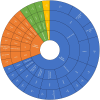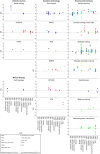Effectiveness of conservative non-pharmacological interventions in people with muscular dystrophies: a systematic review and meta-analysis
- PMID: 38124127
- PMCID: PMC11041561
- DOI: 10.1136/jnnp-2023-331988
Effectiveness of conservative non-pharmacological interventions in people with muscular dystrophies: a systematic review and meta-analysis
Abstract
Introduction: Management of muscular dystrophies (MD) relies on conservative non-pharmacological treatments, but evidence of their effectiveness is limited and inconclusive.
Objective: To investigate the effectiveness of conservative non-pharmacological interventions for MD physical management.
Methods: This systematic review and meta-analysis followed Preferred Reporting Items for Systematic Reviews and Meta-Analyses (PRISMA) guidelines and searched Medline, CINHAL, Embase, AMED and Cochrane Central Register of Controlled Trial (inception to August 2022). Effect size (ES) and 95% Confidence Interval (CI) quantified treatment effect.
Results: Of 31,285 identified articles, 39 studies (957 participants), mostly at high risk of bias, were included. For children with Duchenne muscular dystrophy (DMD), trunk-oriented strength exercises and usual care were more effective than usual care alone in improving distal upper-limb function, sitting and dynamic reaching balance (ES range: 0.87 to 2.29). For adults with Facioscapulohumeral dystrophy (FSHD), vibratory proprioceptive assistance and neuromuscular electrical stimulation respectively improved maximum voluntary isometric contraction and reduced pain intensity (ES range: 1.58 to 2.33). For adults with FSHD, Limb-girdle muscular dystrophy (LGMD) and Becker muscular dystrophy (BMD), strength-training improved dynamic balance (sit-to-stand ability) and self-perceived physical condition (ES range: 0.83 to 1.00). A multicomponent programme improved perceived exertion rate and gait in adults with Myotonic dystrophy type 1 (DM1) (ES range: 0.92 to 3.83).
Conclusions: Low-quality evidence suggests that strength training, with or without other exercise interventions, may improve perceived exertion, distal upper limb function, static and dynamic balance, gait and well-being in MD. Although more robust and larger studies are needed, current evidence supports the inclusion of strength training in MD treatment, as it was found to be safe.
© Author(s) (or their employer(s)) 2024. Re-use permitted under CC BY-NC. No commercial re-use. See rights and permissions. Published by BMJ.
Conflict of interest statement
Competing interests: None declared.
Figures





References
Publication types
MeSH terms
LinkOut - more resources
Full Text Sources
Medical
